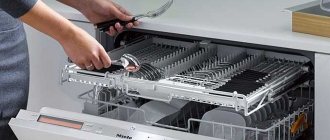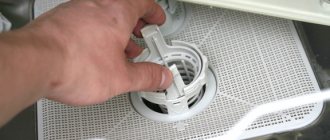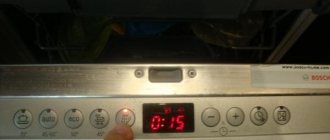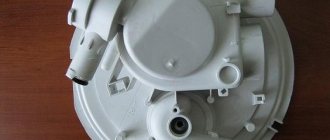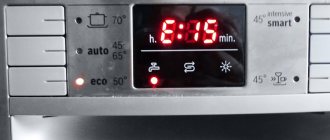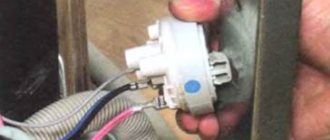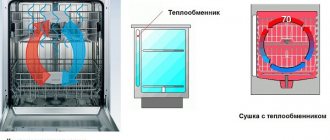Many of us have encountered this situation: when removing dishes with wet hands or touching the metal parts of the dishwasher body, a slight electric shock is felt. Conventionally, the reasons for this behavior of the device can be divided into two groups. The first is associated with internal damage to the unit, the second is caused by faulty wiring or incorrect connection to the network. Why does the dishwasher electrocute from time to time, and what should I do in this case? In our article we will try to provide answers to these questions.
Damage to the machine itself
This applies to equipment that has served you for many years. Possible damage inside the machine:
- the integrity of the insulation on the wires is broken;
- engine malfunction;
- Damage to the heating element or its switching relay.
Of all the listed reasons why a dishwasher periodically shocks, the most common is the last one. Damage to the heating element occurs due to poor quality of the supplied water. You can open the housing yourself and inspect the heating element for defects. If damage is still found, it will be necessary to replace the part with a new one.
Remember! Dishwasher repairs should only be carried out by a specialist.
Some useful tips
In addition to the basic instructions, it is better to know a few more secrets and rules for organizing the grounding and operation of the dishwasher itself. If you keep them in mind, the machine will last a long time and trouble-free. So, you should remember:
- Do not use an extension cord for your dishwasher.
- Do not join copper and aluminum together.
- Do not cut the ground pin out of a three-wire wire.
- The machine is connected only to a power source of suitable power.
- If the plug of the dishwasher cord does not fit into the grooves of the socket, then the latter must be replaced with a new one.
- The use of intermediate conductors and all kinds of tees and adapters is prohibited.
- Once every six months it is necessary to tighten the grounding terminal in the panel, and once a year - directly on the circuit.
The dishwasher is powered by electricity and interacts with water, so every owner of the dishwasher must ground the dishwasher. It’s up to everyone to decide whether to do it themselves or turn to professionals, but you definitely shouldn’t neglect safety and protection from current. The main thing is not to leave this matter unfinished.
Interesting:
- Share your opinion - leave a comment
Safe operation of this useful kitchen appliance requires grounding. This is a responsible job that requires certain knowledge. Therefore, many owners of such equipment turn to the service department for help. However, if desired, you can completely ground the dishwasher yourself.
Wiring fault
This problem is typical for machines that have recently been put into operation. The dishwasher is a fairly powerful device, so it is necessary to select the correct electrical wiring so that it can withstand the load. Calculate the cable cross-section, taking into account that the diameter of the copper cores must be at least 2 mm. Electricity will come from a distribution box or panel. For more reliable protection, purchase a circuit breaker. If your house has old wiring, it is better to replace it with new one, adding various protective devices.
Creating Grounding
If we are talking about an old building, especially a Khrushchev building, then there is probably no grounding in it. In this case, you will have to create a grounding system yourself.
The work is performed in this order:
- You will need a copper wire with three cores. The core cross-section is 3×1.5 square millimeters. An alternative to copper is an aluminum conductor with a cross-section of 3x4.5 square millimeters.
- Lay the wire along the wall to the electrical panel, which is usually located directly in front of the apartment - on the floor landing. Secure the wire using self-tapping screws or dowels.
- Strip the edges of the cable by 2-3 centimeters.
- Find a ground connection on the back of the dishwasher. Electrical equipment usually has a corresponding symbol. Secure the other end of the wire to the desired connector.
Note! If the plug does not fit, the only reasonable solution is to remove the old socket and install a new one. No intermediate conductors or adapters are allowed. Otherwise, there is a risk of equipment overheating and fire.
It is possible to create a grounding connection for a dishwasher even in a country house. In this case, a slightly more complex connection diagram is used:
- Move one meter away from the outer part of one of the walls of the building. Dig a triangular trench. The side of the triangle is 2 meters, the depth of the trench is 50 centimeters.
- Place metal grounding conductors along the tops of the triangular trench. Each electrode is a steel rod 3 meters long.
- Use a welding machine to create welded connections between grounding conductors (do not forget about safety precautions, use a welding helmet and gloves). The connection between the electrodes is made through a steel strip.
- The next task is connecting the circuit to the building's electrical panel. To do this, use copper wire with a cross-section of 3×1.5 square millimeters.
- Connect the connecting wire to the dishwasher from a grounded electrical panel.
- Check the resistance level in the grounding system with a multimeter.
If the connection is incorrect, there is still a risk of electric shock. Therefore, you should take on this work only with complete confidence in your own abilities. Otherwise, it is better to seek help from a competent electrician.
Many people ask how to ground a washing machine, because not only old, but also fully functional equipment can get an electric shock. This happens because the internal surge filter, consisting of two capacitors, or rather its design, involves connecting the washing machine body to the neutral wire.
Thus, if the washing machine is connected to an electrical network that has only two wires, the static charge does not have the opportunity to flow from the body to the neutral wire.
Don’t be surprised, but on the body of almost all washing machines, due to the lack of protective grounding and a neutral wire, a current of 110 volts appears.
In addition to the surge protector, the cause of an electric shock can also be a violation of the wiring insulation. In this case, the phase ends up on the housing, the current on which will be up to 220 volts with all the ensuing consequences.
To eliminate the threat to life, an automatic protective shutdown device should be installed in the washing machine circuit or a protective grounding of the housing should be provided, or a combination of both methods. Let us dwell in detail on grounding, because the RCD does not protect 100%.
The essence of protective grounding is to ensure that when the insulation breaks down, the electric current flows into the ground electrode. But you need to remember the following nuances:
Incorrect electrical connection
One of the reasons leading to the machine receiving an electric shock may be a violation of the rules for connecting the device to the electrical network.
Before installation, carefully read the operating instructions for the dishwasher. Manufacturers set their own connection rules, since the technical characteristics of all devices are different. But there is a general recommendation that applies to all models: the device should be connected to the power supply only through a Euro socket with reliable grounding.
Remember! Operating equipment without grounding is unacceptable!
Operating principle of RCD
If there is no European socket, then it makes sense to install it, at least in the room where you plan to connect the dishwasher. The idea of replacing the factory Euro plug with a “Soviet” one should be immediately abandoned for reasons of electrical safety. In addition, you automatically void the product warranty. In modern apartments, instead of grounding, grounding is often done: the wire is connected to a solid neutral. Under no circumstances try to do this yourself - it won’t take a specialist much time, but it could cost you your life.
If changing the wiring is not possible, use a residual current device that will cut off the power supply in the event of a leak.
An RCD will not save you from electric shock, it will only reduce its strength. Before installation, carefully read the operating instructions to determine which type of device is suitable for your model.
Causes
Why is the dishwasher electrocuted? Yes, because there is a current leakage onto the body of the machine. All the reasons for this can be divided into two groups, the first group is associated with a malfunction of the machine itself and most often occurs after some time of using the equipment. The second group of reasons is associated with improper connection of the dishwasher, or rather with the electrical network. At the same time, even a new machine can start to “bite”. We list all possible reasons:
- the insulation of the wiring inside the dishwasher is broken;
- the engine of the car is broken;
- heater breakdown;
- the socket is faulty;
- there is no grounding.
Checking the heating element
Most often, the reason that a car is electrocuted lies in a broken heating element. To check it, you need to remove the heater, for this you need:
- disconnect equipment from the network and water supply;
- remove the dish baskets, garbage filter and sprinklers from the tank;
- if there is one, unscrew the screws under the mesh (at the bottom of the tank);
- turn the dishwasher over so that you can access its bottom;
- remove the bottom;
- we find the heater and disconnect it from the pipe;
- disconnect all the chips with wires from the heating element;
- we take out the heater and inspect it; already at this stage a breakdown can be detected;
- To verify the malfunction, you can lower the heating element into a salt solution, and then measure the resistance between the heater and the solution. If the device shows resistance, it means the heater is broken.
- if there really is a breakdown of the part, replace the heater with a new one.
The second way to check the heater is dry as follows:
- set the unit of measurement on the multimeter to Ohms;
- apply the probe of the device to the contacts of the heater;
- a serviceable part has a resistance within 21-22 Ohms, a faulty one has an infinite resistance;
- after checking the heater, check the part for current leakage to the body, switching the multimeter to MegaOhms for this;
- We place one probe of the device on the contact of the heater, and the second on its body. It can be applied not to the body, but to the grounding contact. If the heater is working properly, there should be infinite resistance on the device.
How to check wiring and motor
It seems clear why the dishwasher shocks you, but what do you do when it behaves like this? Quite often the leak is caused by wiring or the engine housing. In our practice, there have been cases when mice appeared in the dishwasher and, gnawing on the wiring, created a similar problem.
Even if there are no mice in the machine, the bulk wiring inside could be defective, with damaged insulation, or the insulation has become frayed over time
Visually inspect each wire, especially pay attention to the bases of each wire where they connect to chips or terminals. If you find a damaged wire, replace it
If you have the skill, you can use a multimeter. It also helps in finding a damaged wire, but visual inspection has not been canceled. If the wiring is OK, check the engine. If the winding leaks onto the housing, then the engine may well begin to shock. This can also be checked easily using a multimeter. A broken winding is not suitable for further operation; the motor will have to be replaced. You can, of course, try to rewind the part, but this will cost more.
So, you shouldn’t ignore this problem with your dishwasher. But how to fix it, make a decision yourself, call a technician or look for and fix the problem yourself. Just remember, you need to be extremely careful with electricity!
How to properly ground a washing machine?
The easiest way is to equip a potential equalization system and install an RCD. Don't forget to double-check the wire insulation.
If you live in a house that was built a long time ago, then it is clear that neither grounding nor connection of high-power electrical equipment is provided, and you can properly ground a washing machine either by creating a grounding loop or through secondary grounding (grounding).
Of course, it will be very easy to make grounding if you use metal water pipes or heating pipes to drain stray currents.
But I believe that this should not be done, because due to such grounding, stainless steel risers may soon become leaky and a water leak will occur.
If the sieve on the pipes does not scare you, then ground the washing machine as follows.
Fasten the first end of the single-core wire to the body of the washing machine, and fix the other end to the riser. Connect conscientiously - otherwise there is little use. It is better to even remove the paint from the pipe at the junction.
Then it is necessary to create a small but effective ground loop. To do this, you need to run the wire along the wall of the house to the ground and connect it to a piece of reinforcement that has been previously driven into the ground at least a meter long, and preferably at least two.
How to ground a washing machine outlet?
Another way, and, in my opinion, more preferable, is to re-ground (ground) the washing machine. Check it out and then decide how to ground a washing machine at home, but I choose this method.
So, everyone knows that the neutral in the electrical wiring of a house is essentially a kind of ground, so you can use this property as grounding.
However, it is stupid to take and connect the neutral wire to the ground terminal and the socket terminal, because in the event of a breakdown of the wires... I don’t even want to say...
The re-grounding device should be carried out at the point where electricity enters the house, that is, at the electrical panel.
From the ground, busbars must be installed separately on the grounding and the neutral wire, and then the electrical wiring must be installed.
Thus, in order to connect and properly ground the washing machine, you should remove the three-wire wire from the electrical panel and install a grounded socket.
Inside the shield, connect the wires exactly to their places. We connect the phase to the machine, the zero to the first bus, and the ground to the other.
By the way, it is better to use a 45 Ampere circuit breaker for a washing machine.
Lay the cables exclusively in whole pieces, without using twists, or do the twists in a special mounting box with insulation. It is preferable to install the outlet for the washing machine outside the bathroom if it is not waterproof.
